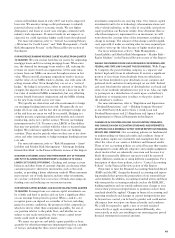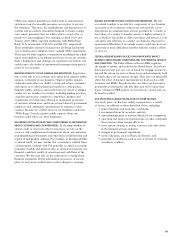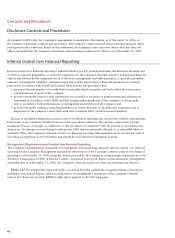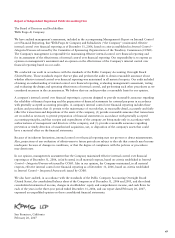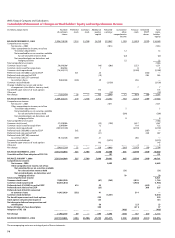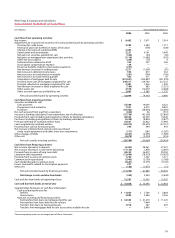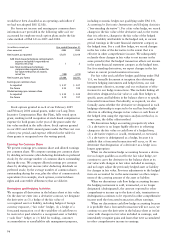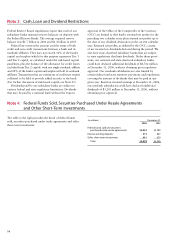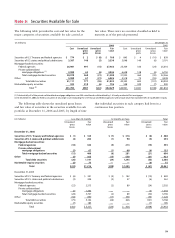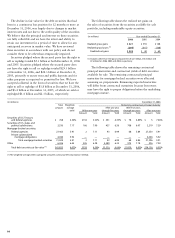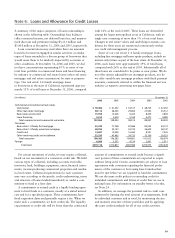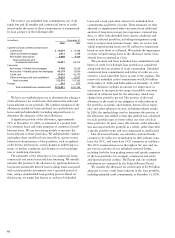Wells Fargo 2006 Annual Report Download - page 75
Download and view the complete annual report
Please find page 75 of the 2006 Wells Fargo annual report below. You can navigate through the pages in the report by either clicking on the pages listed below, or by using the keyword search tool below to find specific information within the annual report.
73
portfolio yield within capital risk limits approved by
management and the Board of Directors and monitored by
the Corporate Asset/Liability Management Committee. We
recognize realized gains and losses on the sale of these securities
in noninterest income using the specific identification method.
Unamortized premiums and discounts are recognized in
interest income over the contractual life of the security using
the interest method. As principal repayments are received on
securities (i.e., primarily mortgage-backed securities) a pro-rata
portion of the unamortized premium or discount is recognized
in interest income.
NONMARKETABLE EQUITY SECURITIES Nonmarketable equity
securities include venture capital equity securities that are
not publicly traded and securities acquired for various pur-
poses, such as to meet regulatory requirements (for example,
Federal Reserve Bank and Federal Home Loan Bank stock).
We review these assets at least quarterly for possible other-
than-temporary impairment. Our review typically includes
an analysis of the facts and circumstances of each invest-
ment, the expectations for the investment’s cash flows and
capital needs, the viability of its business model and our exit
strategy. These securities are accounted for under the cost or
equity method and are included in other assets. We reduce
the asset value when we consider declines in value to be
other than temporary. We recognize the estimated loss as
a loss from equity investments in noninterest income.
Mortgages Held for Sale
Mortgages held for sale include residential mortgages that
were originated in accordance with secondary market pricing
and underwriting standards and certain mortgages originated
initially for investment and not underwritten to secondary
market standards, and are stated at the lower of cost or market
value. Gains and losses on loan sales (sales proceeds minus
carrying value) are recorded in noninterest income. Direct
loan origination costs and fees are deferred at origination
of the loan. These deferred costs and fees are recognized in
mortgage banking noninterest income upon sale of the loan.
Loans Held for Sale
Loans held for sale are carried at the lower of cost or market
value. Gains and losses on loan sales (sales proceeds minus
carrying value) are recorded in noninterest income. Direct
loan origination costs and fees are deferred at origination
of the loan. These deferred costs and fees are recognized
in noninterest income upon sale of the loan.
Loans
Loans are reported at their outstanding principal balances
net of any unearned income, charge-offs, unamortized
deferred fees and costs on originated loans and premiums or
discounts on purchased loans, except for certain purchased
loans, which are recorded at fair value on their purchase date.
Unearned income, deferred fees and costs, and discounts and
premiums are amortized to income over the contractual life
of the loan using the interest method.
Lease financing assets include aggregate lease rentals, net
of related unearned income, which includes deferred investment
tax credits, and related nonrecourse debt. Leasing income
is recognized as a constant percentage of outstanding lease
financing balances over the lease terms.
Loan commitment fees are generally deferred and amor-
tized into noninterest income on a straight-line basis over the
commitment period.
From time to time, we pledge loans, primarily 1-4 family
mortgage loans, to secure borrowings from the Federal
Home Loan Bank.
NONACCRUAL LOANS We generally place loans on nonaccrual
status when:
• the full and timely collection of interest or principal
becomes uncertain;
• they are 90 days (120 days with respect to real estate
1-4 family first and junior lien mortgages and auto
loans) past due for interest or principal (unless both
well-secured and in the process of collection); or
• part of the principal balance has been charged off.
Generally, consumer loans not secured by real estate or
autos are placed on nonaccrual status only when part of the
principal has been charged off. These loans are charged off
or charged down to the net realizable value of the collateral
when deemed uncollectible, due to bankruptcy or other fac-
tors, or when they reach a defined number of days past due
based on loan product, industry practice, country, terms and
other factors.
When we place a loan on nonaccrual status, we reverse
the accrued and unpaid interest receivable against interest
income and account for the loan on the cash or cost recovery
method, until it qualifies for return to accrual status. Generally,
we return a loan to accrual status when (a) all delinquent
interest and principal becomes current under the terms of the
loan agreement or (b) the loan is both well-secured and in the
process of collection and collectibility is no longer doubtful.
IMPAIRED LOANS We assess, account for and disclose as impaired
certain nonaccrual commercial and commercial real estate
loans that are over $3 million. We consider a loan to be
impaired when, based on current information and events, we
will probably not be able to collect all amounts due according
to the loan contract, including scheduled interest payments.
When we identify a loan as impaired, we measure the
impairment based on the present value of expected future
cash flows, discounted at the loan’s effective interest rate,
except when the sole (remaining) source of repayment for
the loan is the operation or liquidation of the collateral. In
these cases we use an observable market price or the current
fair value of the collateral, less selling costs when foreclosure
is probable, instead of discounted cash flows.
If we determine that the value of the impaired loan is less
than the recorded investment in the loan (net of previous
charge-offs, deferred loan fees or costs and unamortized
premium or discount), we recognize impairment through an
allowance estimate or a charge-off to the allowance.


